Descriptive and prescriptive grammar in teaching English
This article aims to make it clear that it is not quite satisfactory if we
attribute any language difference between authentic English and the English we are
learning and teaching only to the informal style. By analyzing a number of examples, the
writer assumes that many Vietnamese learners believe that English taught at school and
English spoken by native English people share one and the same grammar. In fact, the
English grammar we learn is just one type of grammar (prescriptive grammar) and native
English people have their own grammar in communication (descriptive grammar). Based
on some differences, the writer offers a number of pedagogical suggestions to deal with the
differences between the two types of grammar in English
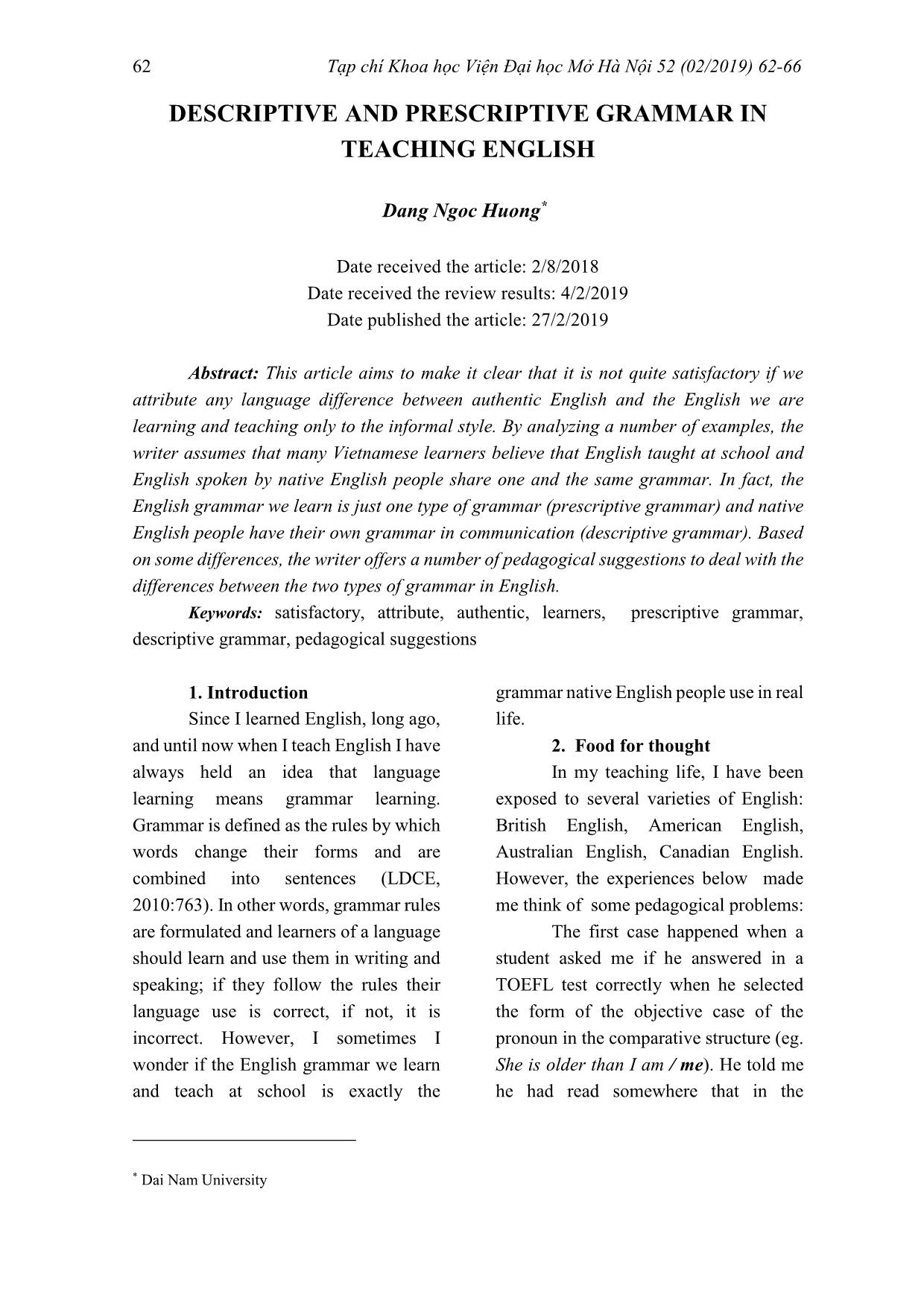
Trang 1
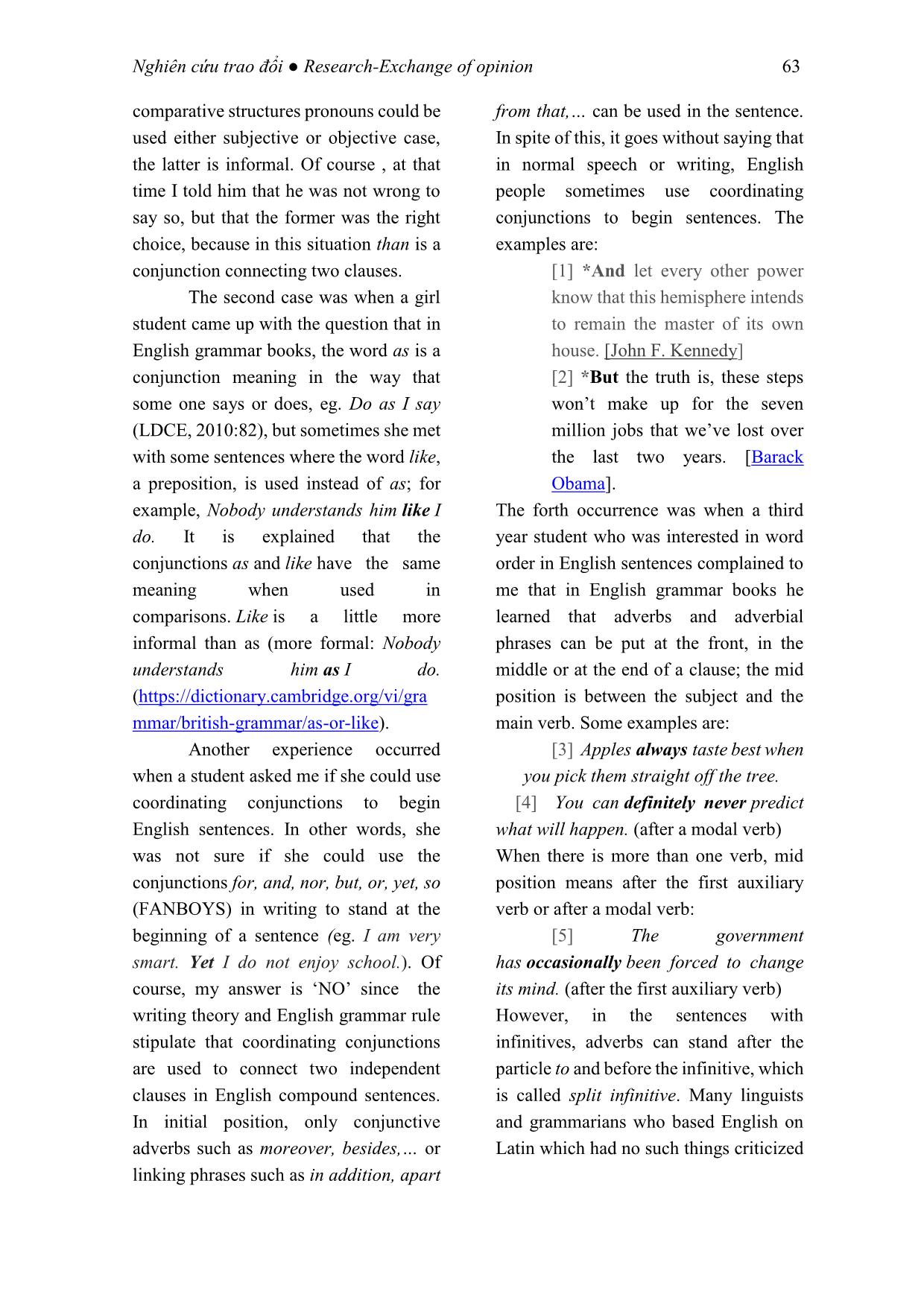
Trang 2
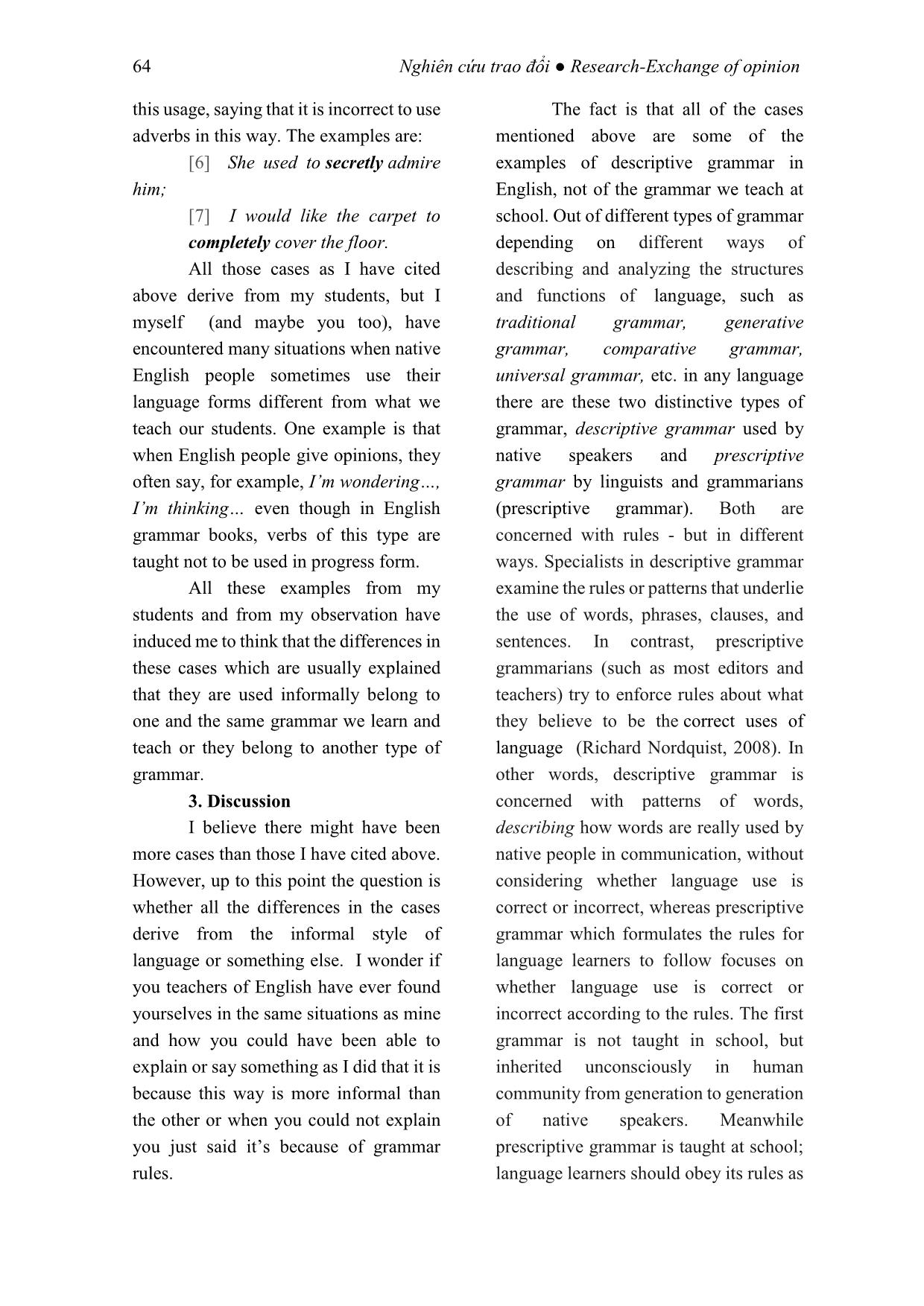
Trang 3
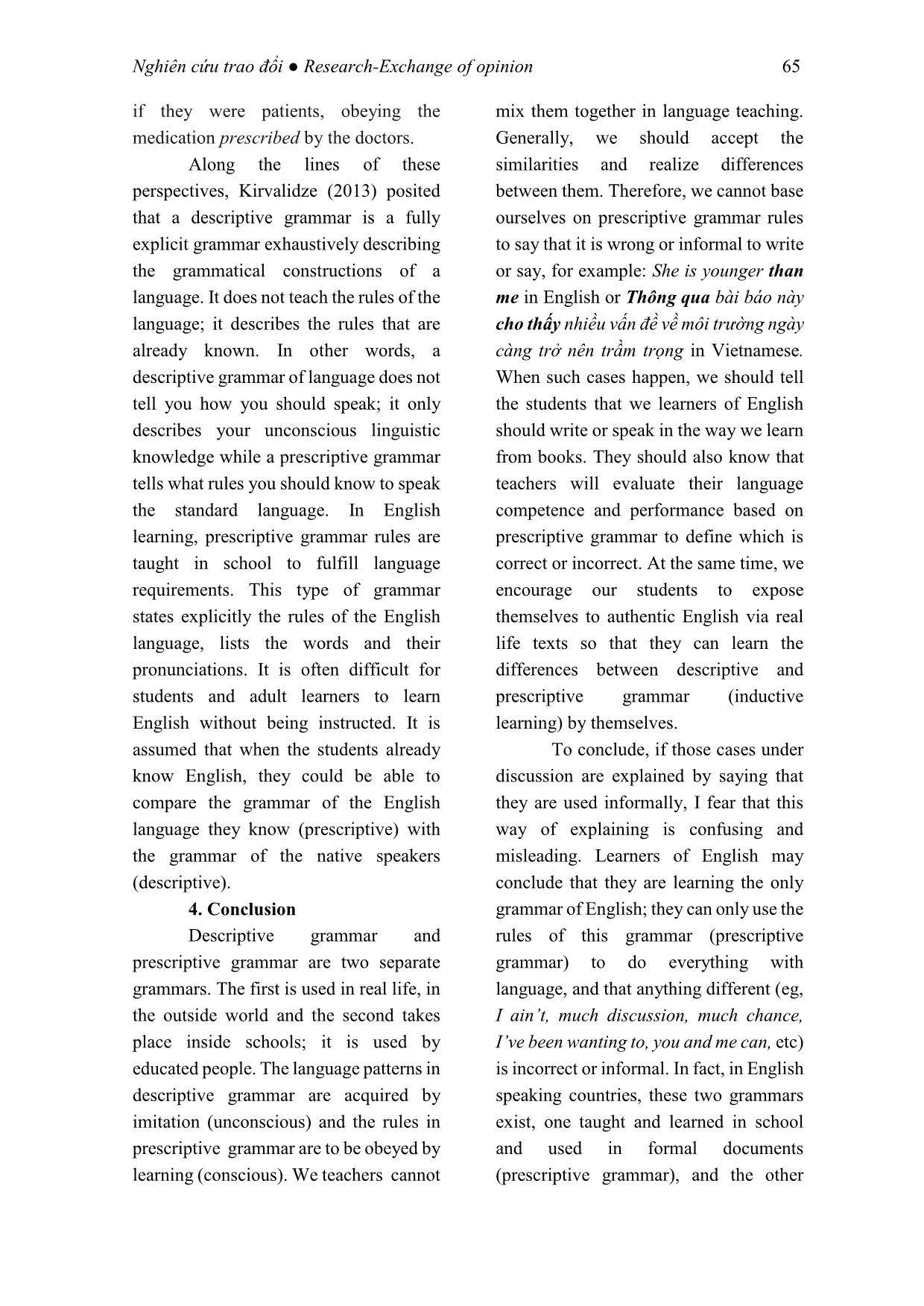
Trang 4
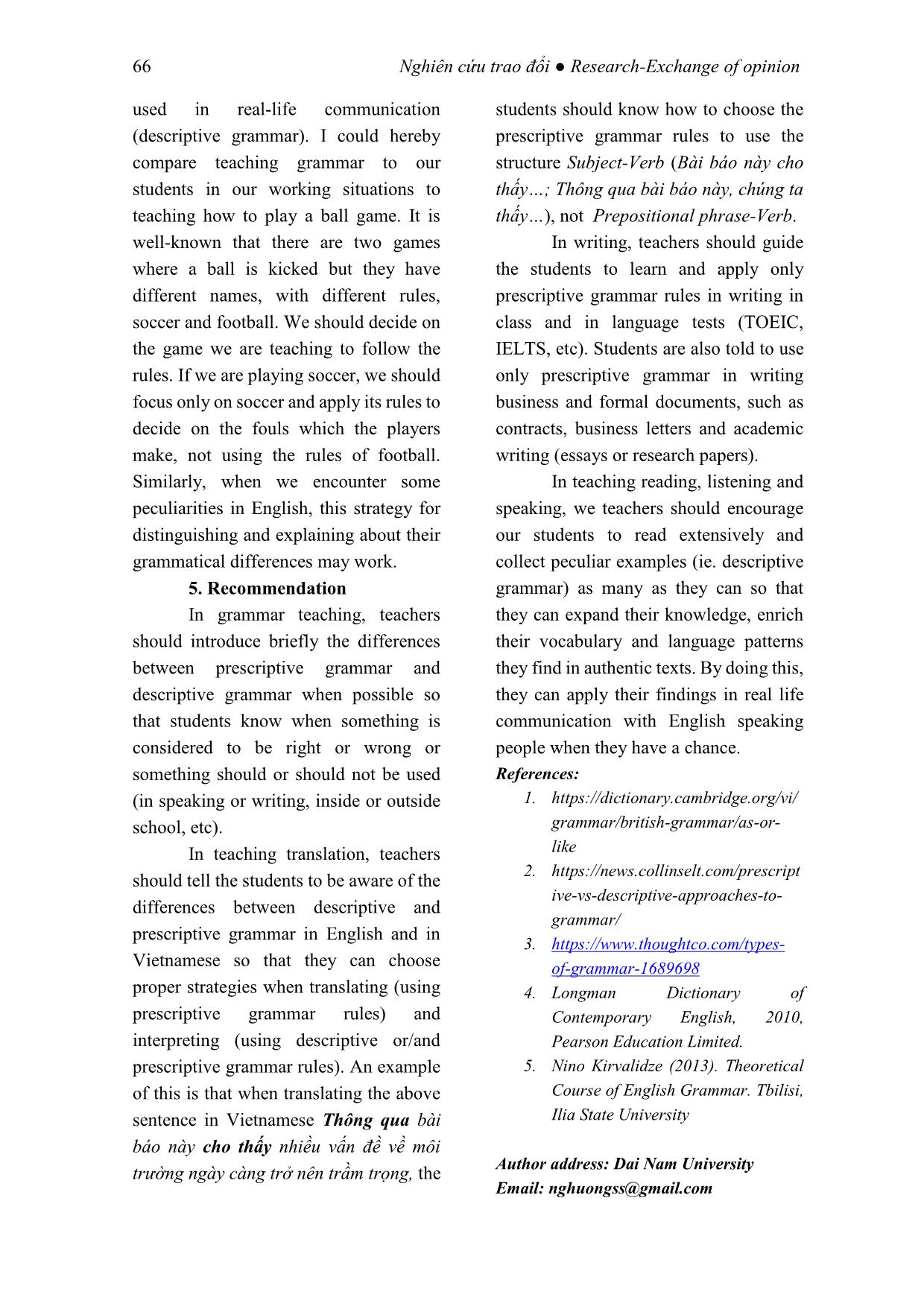
Trang 5
Tóm tắt nội dung tài liệu: Descriptive and prescriptive grammar in teaching English
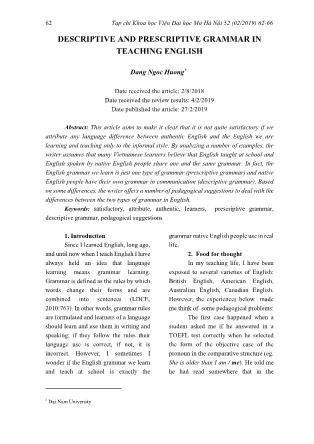
ults: 4/2/2019 Date published the article: 27/2/2019 Abstract: This article aims to make it clear that it is not quite satisfactory if we attribute any language difference between authentic English and the English we are learning and teaching only to the informal style. By analyzing a number of examples, the writer assumes that many Vietnamese learners believe that English taught at school and English spoken by native English people share one and the same grammar. In fact, the English grammar we learn is just one type of grammar (prescriptive grammar) and native English people have their own grammar in communication (descriptive grammar). Based on some differences, the writer offers a number of pedagogical suggestions to deal with the differences between the two types of grammar in English. Keywords: satisfactory, attribute, authentic, learners, prescriptive grammar, descriptive grammar, pedagogical suggestions 1. Introduction Since I learned English, long ago, and until now when I teach English I have always held an idea that language learning means grammar learning. Grammar is defined as the rules by which words change their forms and are combined into sentences (LDCE, 2010:763). In other words, grammar rules are formulated and learners of a language should learn and use them in writing and speaking; if they follow the rules their language use is correct, if not, it is incorrect. However, I sometimes I wonder if the English grammar we learn and teach at school is exactly the * Dai Nam University grammar native English people use in real life. 2. Food for thought In my teaching life, I have been exposed to several varieties of English: British English, American English, Australian English, Canadian English. However, the experiences below made me think of some pedagogical problems: The first case happened when a student asked me if he answered in a TOEFL test correctly when he selected the form of the objective case of the pronoun in the comparative structure (eg. She is older than I am / me). He told me he had read somewhere that in the Nghiên cứu trao đổi ● Research-Exchange of opinion 63 comparative structures pronouns could be used either subjective or objective case, the latter is informal. Of course , at that time I told him that he was not wrong to say so, but that the former was the right choice, because in this situation than is a conjunction connecting two clauses. The second case was when a girl student came up with the question that in English grammar books, the word as is a conjunction meaning in the way that some one says or does, eg. Do as I say (LDCE, 2010:82), but sometimes she met with some sentences where the word like, a preposition, is used instead of as; for example, Nobody understands him like I do. It is explained that the conjunctions as and like have the same meaning when used in comparisons. Like is a little more informal than as (more formal: Nobody understands him as I do. (https://dictionary.cambridge.org/vi/gra mmar/british-grammar/as-or-like). Another experience occurred when a student asked me if she could use coordinating conjunctions to begin English sentences. In other words, she was not sure if she could use the conjunctions for, and, nor, but, or, yet, so (FANBOYS) in writing to stand at the beginning of a sentence (eg. I am very smart. Yet I do not enjoy school.). Of course, my answer is ‘NO’ since the writing theory and English grammar rule stipulate that coordinating conjunctions are used to connect two independent clauses in English compound sentences. In initial position, only conjunctive adverbs such as moreover, besides, or linking phrases such as in addition, apart from that, can be used in the sentence. In spite of this, it goes without saying that in normal speech or writing, English people sometimes use coordinating conjunctions to begin sentences. The examples are: [1] *And let every other power know that this hemisphere intends to remain the master of its own house. [John F. Kennedy] [2] *But the truth is, these steps won’t make up for the seven million jobs that we’ve lost over the last two years. [Barack Obama]. The forth occurrence was when a third year student who was interested in word order in English sentences complained to me that in English grammar books he learned that adverbs and adverbial phrases can be put at the front, in the middle or at the end of a clause; the mid position is between the subject and the main verb. Some examples are: [3] Apples always taste best when you pick them straight off the tree. [4] You can definitely never predict what will happen. (after a modal verb) When there is more than one verb, mid position means after the first auxiliary verb or after a modal verb: [5] The government has occasionally been forced to change its mind. (after the first auxiliary verb) However, in the sentences with infinitives, adverbs can stand after the particle to and before the infinitive, which is called split infinitive. Many linguists and grammarians who based English on Latin which had no such things criticized 64 Nghiên cứu trao đổi ● Research-Exchange of opinion this usage, saying that it is incorrect to use adverbs in this way. The examples are: [6] She used to secretly admire him; [7] I would like the carpet to completely cover the floor. All those cases as I have cited above derive from my students, but I myself (and maybe you too), have encountered many situations when native English people sometimes use their language forms different from what we teach our students. One example is that when English people give opinions, they often say, for example, I’m wondering, I’m thinking even though in English grammar books, verbs of this type are taught not to be used in progress form. All these examples from my students and from my observation have induced me to think that the differences in these cases which are usually explained that they are used informally belong to one and the same grammar we learn and teach or they belong to another type of grammar. 3. Discussion I believe there might have been more cases than those I have cited above. However, up to this point the question is whether all the differences in the cases derive from the informal style of language or something else. I wonder if you teachers of English have ever found yourselves in the same situations as mine and how you could have been able to explain or say something as I did that it is because this way is more informal than the other or when you could not explain you just said it’s because of grammar rules. The fact is that all of the cases mentioned above are some of the examples of descriptive grammar in English, not of the grammar we teach at school. Out of different types of grammar depending on different ways of describing and analyzing the structures and functions of language, such as traditional grammar, generative grammar, comparative grammar, universal grammar, etc. in any language there are these two distinctive types of grammar, descriptive grammar used by native speakers and prescriptive grammar by linguists and grammarians (prescriptive grammar). Both are concerned with rules - but in different ways. Specialists in descriptive grammar examine the rules or patterns that underlie the use of words, phrases, clauses, and sentences. In contrast, prescriptive grammarians (such as most editors and teachers) try to enforce rules about what they believe to be the correct uses of language (Richard Nordquist, 2008). In other words, descriptive grammar is concerned with patterns of words, describing how words are really used by native people in communication, without considering whether language use is correct or incorrect, whereas prescriptive grammar which formulates the rules for language learners to follow focuses on whether language use is correct or incorrect according to the rules. The first grammar is not taught in school, but inherited unconsciously in human community from generation to generation of native speakers. Meanwhile prescriptive grammar is taught at school; language learners should obey its rules as Nghiên cứu trao đổi ● Research-Exchange of opinion 65 if they were patients, obeying the medication prescribed by the doctors. Along the lines of these perspectives, Kirvalidze (2013) posited that a descriptive grammar is a fully explicit grammar exhaustively describing the grammatical constructions of a language. It does not teach the rules of the language; it describes the rules that are already known. In other words, a descriptive grammar of language does not tell you how you should speak; it only describes your unconscious linguistic knowledge while a prescriptive grammar tells what rules you should know to speak the standard language. In English learning, prescriptive grammar rules are taught in school to fulfill language requirements. This type of grammar states explicitly the rules of the English language, lists the words and their pronunciations. It is often difficult for students and adult learners to learn English without being instructed. It is assumed that when the students already know English, they could be able to compare the grammar of the English language they know (prescriptive) with the grammar of the native speakers (descriptive). 4. Conclusion Descriptive grammar and prescriptive grammar are two separate grammars. The first is used in real life, in the outside world and the second takes place inside schools; it is used by educated people. The language patterns in descriptive grammar are acquired by imitation (unconscious) and the rules in prescriptive grammar are to be obeyed by learning (conscious). We teachers cannot mix them together in language teaching. Generally, we should accept the similarities and realize differences between them. Therefore, we cannot base ourselves on prescriptive grammar rules to say that it is wrong or informal to write or say, for example: She is younger than me in English or Thông qua bài báo này cho thấy nhiều vấn đề về môi trường ngày càng trở nên trầm trọng in Vietnamese. When such cases happen, we should tell the students that we learners of English should write or speak in the way we learn from books. They should also know that teachers will evaluate their language competence and performance based on prescriptive grammar to define which is correct or incorrect. At the same time, we encourage our students to expose themselves to authentic English via real life texts so that they can learn the differences between descriptive and prescriptive grammar (inductive learning) by themselves. To conclude, if those cases under discussion are explained by saying that they are used informally, I fear that this way of explaining is confusing and misleading. Learners of English may conclude that they are learning the only grammar of English; they can only use the rules of this grammar (prescriptive grammar) to do everything with language, and that anything different (eg, I ain’t, much discussion, much chance, I’ve been wanting to, you and me can, etc) is incorrect or informal. In fact, in English speaking countries, these two grammars exist, one taught and learned in school and used in formal documents (prescriptive grammar), and the other 66 Nghiên cứu trao đổi ● Research-Exchange of opinion used in real-life communication (descriptive grammar). I could hereby compare teaching grammar to our students in our working situations to teaching how to play a ball game. It is well-known that there are two games where a ball is kicked but they have different names, with different rules, soccer and football. We should decide on the game we are teaching to follow the rules. If we are playing soccer, we should focus only on soccer and apply its rules to decide on the fouls which the players make, not using the rules of football. Similarly, when we encounter some peculiarities in English, this strategy for distinguishing and explaining about their grammatical differences may work. 5. Recommendation In grammar teaching, teachers should introduce briefly the differences between prescriptive grammar and descriptive grammar when possible so that students know when something is considered to be right or wrong or something should or should not be used (in speaking or writing, inside or outside school, etc). In teaching translation, teachers should tell the students to be aware of the differences between descriptive and prescriptive grammar in English and in Vietnamese so that they can choose proper strategies when translating (using prescriptive grammar rules) and interpreting (using descriptive or/and prescriptive grammar rules). An example of this is that when translating the above sentence in Vietnamese Thông qua bài báo này cho thấy nhiều vấn đề về môi trường ngày càng trở nên trầm trọng, the students should know how to choose the prescriptive grammar rules to use the structure Subject-Verb (Bài báo này cho thấy; Thông qua bài báo này, chúng ta thấy), not Prepositional phrase-Verb. In writing, teachers should guide the students to learn and apply only prescriptive grammar rules in writing in class and in language tests (TOEIC, IELTS, etc). Students are also told to use only prescriptive grammar in writing business and formal documents, such as contracts, business letters and academic writing (essays or research papers). In teaching reading, listening and speaking, we teachers should encourage our students to read extensively and collect peculiar examples (ie. descriptive grammar) as many as they can so that they can expand their knowledge, enrich their vocabulary and language patterns they find in authentic texts. By doing this, they can apply their findings in real life communication with English speaking people when they have a chance. References: 1. https://dictionary.cambridge.org/vi/ grammar/british-grammar/as-or- like 2. https://news.collinselt.com/prescript ive-vs-descriptive-approaches-to- grammar/ 3. https://www.thoughtco.com/types- of-grammar-1689698 4. Longman Dictionary of Contemporary English, 2010, Pearson Education Limited. 5. Nino Kirvalidze (2013). Theoretical Course of English Grammar. Tbilisi, Ilia State University Author address: Dai Nam University Email: nghuongss@gmail.com
File đính kèm:
 descriptive_and_prescriptive_grammar_in_teaching_english.pdf
descriptive_and_prescriptive_grammar_in_teaching_english.pdf

